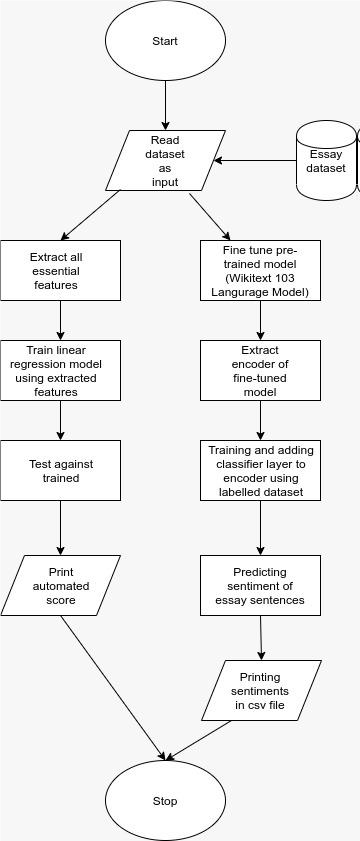Transfer Learning based Automated Essay Summarization
Main Article Content
Abstract
The human evaluation of essays has become a very time-consuming process as the number of schools and universities has grown. The available software entities are unable to assess the sentiment associated with essays. Thus, we propose a model using Natural Language Processing to assess the essay based on both grammar and sentiment associated with the essay by using linear regression and ULMFiT (Universal Language Model Fine-tuning for Text Classification) models. Evaluation of essay is done in two parts. Part one is on essay grading with respect to grammar with maximum 12 and minimum 0 grade points and in part two score of 0/1 for sentiment analysis with 0 being negative and 1 being positive. The model can be used to score the essay and discard any essay with a score less than a specified value or specified sentiment score.
Article Details
References
Jeremy Howard and Sebastian Ruder.. Universal Language Model Fine-tuning for Text Classification. In Proceedings of the 56th Annual Meeting of the Association for Computational Linguistics (Volume 1: Long Papers), Melbourne, Australia. Association for Computational Linguistics, pages 328–339, 2018.
Song, Shihui, and Jason Zhao. "Automated Essay Scoring Using Machine Learning." –Mach. Learning Sessions, Stanford University, 2012 – Citeseer
Sandeep Mathias and PushpakBhattacharyya.. ASAP++: Enriching the ASAP Automated Essay Grading Dataset with Essay Attribute Scores. In Proceedings of the Eleventh International Conference on Language Resources and Evaluation (LREC 2018), Miyazaki, Japan. European Language Resources Association (ELRA), 2018.
T. K. Shivaprasad and J. Shetty, "Sentiment analysis of product reviews: A review," International Conference on Inventive Communication and Computational Technologies (ICICCT), 2017, pp. 298-301, 2017, doi: 10.1109/ICICCT.2017.7975207.
Batra, P., Chaudhary, S., Bhatt, K., Varshney, S. and Verma, S., 2020, August. A Review: Abstractive Text Summarization Techniques using NLP. In 2020 International Conference on Advances in Computing, Communication & Materials (ICACCM), pp. 23-28.
Singh, P., Chhikara, P. and Singh, J., 2020, February. An ensemble approach for extractive text summarization. In 2020 International Conference on Emerging Trends in Information Technology and Engineering (ic-ETITE), pp. 1-7.
Nazemi, K., Klepsch, M.J., Burkhardt, D. and Kaupp, L., 2020, September. Comparison of full-text articles and abstracts for visual trend analytics through natural language processing. In 2020 24th International Conference Information Visualisation (IV) (pp. 360-367).
Safwat, H., Gruzitis, N., Davis, B. and Enache, R., 2016, February. Extracting semantic knowledge from unstructured text using embedded controlled language. In 2016 IEEE Tenth International Conference on Semantic Computing (ICSC), pp. 87-90.
Shah, J., Sagathiya, M., Redij, K. and Hole, V., 2020, July. Natural language processing based abstractive text summarization of reviews. In 2020 International Conference on Electronics and Sustainable Communication Systems (ICESC), pp. 461-466.
Adhikari, S., 2020, March. Nlp based machine learning approaches for text summarization. In 2020 Fourth International Conference on Computing Methodologies and Communication (ICCMC), pp. 535-538.
Kudi, P., Manekar, A., Daware, K. and Dhatrak, T., 2014, December. Online Examination with short text matching. In 2014 IEEE Global Conference on Wireless Computing & Networking (GCWCN), pp. 56-60.
Srivastava, Nitish, et al. "Dropout: a simple way to prevent neural networks from overfitting." The journal of machine learning research 15.1 (2014): 1929-1958.
Cho, Kyunghyun, et al. "Learning phrase representations using RNN encoder-decoder for statistical machine translation." arXiv preprint arXiv:1406.1078 (2014).

